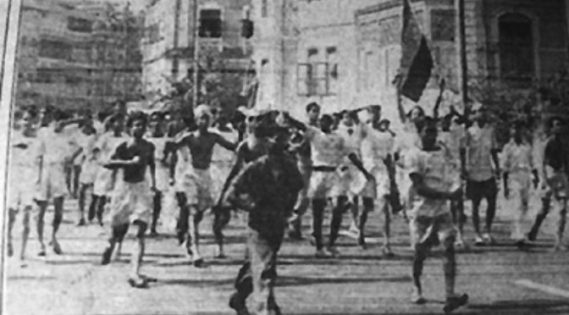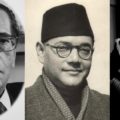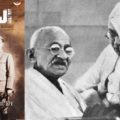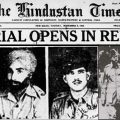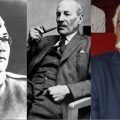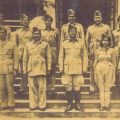There have been attempts all these years to undermine the glorious pivotal role played by the Indian National Army, under the leadership of Netaji Subhas Chandra Bose, and that of the rebellion of the Royal Indian Navy, under the influence of the INA and its Netaji, for the hurried British retreat and consequent transfer of power in 1947. Yes, the British, in general, never wanted to acknowledge the role of the Azad Hind Fauj for obvious reasons and the ‘Nehruvian court-historians’ tried their level best to validate the role of Gandhi-ji’s so-called non-violent movement, mainly to please the alter ego of their mentor and role model, the all powerful Jawaharlal Nehru, the first Prime Minister of the Dominion of India.
That undivided India did not become fully independent on August 15, 1947, but was only divided into two Dominion States under the British Crown, was also downplayed by these ‘court historians’. In fact, the Union Jack was never brought down on August 15, 1947. Only the Indian tricolor was hoisted.
However, History cannot be suppressed for long and since then many records have come out in the public domain which exposed the bluff of the British and the Nehruvian historians. For example, it was Mr. Clement Richard Attlee himself who had spilled the beans, at least to two persons, revealing that the main reason for the British to scurry out of India in August 1947 was because of the erosion of loyalty to the British Crown among the Indian army, Royal Indian Navy and air force personnel as a result of the military activities of Netaji Subhas Chandra Bose and his Indian National Army.
Because of the Wartime censorship, very few Indians came to know till August 1945 that the INA had actually freed Imphal and a good part of the present day Nagaland. Instead, the consequent retreat of the INA because of logistical problems, heavy monsoon rains and the withdrawal of their allies, the Japanese, has been highlighted as their defeat. The heroics of the INA soldiers only came to the wide public knowledge during the INA trials of November and December 1945. When Chief Justice P.B. Chakravartti of the Calcutta High Court asked pointedly in October 1956 about the extent of Gandhi’s influence upon the British decision to quit India, Earl Clement Richard Attlee, who was on a three-week visit to India, had commented that Gandhi’s role was ‘minimal’ and it was the INA and Subhas Chandra Bose who had eroded the loyalty of the Indian soldiers in the Royal Indian Army which made them nervous. It is to be highlighted that Earl Attlee was the British Prime Minister from July 1945 to October 1951 and the Transfer of Power took place during his premiership.
It would not be out of place to highlight here that the Quit India Movement of August 1942 was snuffed out in eight weeks. This is widely known and accepted even by the ‘court historians’. The INA trials had in fact created grounds for popular upsurge of anti-British sentiments among the Indians. While the ‘court historians’ try to point out that though the Royal Indian Navy (RIN) uprising began on February 18, 1946, and the then Labour Party PM Clement Attlee declared his decision of sending the Cabinet Mission in the House of Commons on February 19, 1946, the decision to send the Cabinet Mission was taken in the British Cabinet as early as on January 22, 1946. They want us to forget that the INA trials for the three INA Chiefs had begun at the Red Fort, New Delhi, on November 5, 1945, and they were convicted on December 31, 1945.
To protest the unfair trials, the INA Week was held from November 5 to November 11, 1945, and INA Day was marked on November 12, 1945. A huge procession marched towards Dalhousie Square in Calcutta on November 21, 1945, to protest the unfair trials of the INA soldiers when the police opened fire and killed two, a Hindu and a Muslim, at Dharmatala, Central Calcutta. The firing however could not disperse the procession. The following day, i.e. on November 22, 1945, there were huge public protests all over Calcutta against government’s draconian policy. Calcutta, then the biggest city of British India, came to a standstill. Both the army chief Field Marshal Claude Auchinleck and the Governor General Lord Archibald Percival Wavell were extremely alarmed. The Governor of North-West Frontier Province Sir George Cunningham wrote to the Viceroy Wavell on November 27, 1845, to ask the army chief to immediately cancel the INA trials. We now know from Wavell’s Diary dated November 24, 1945, that Field Marshal Auchinleck was ready to change his stand on the apprehension that the INA trials might adversely affect the loyalty of the British Indian Army personnel and instructions had been sought from London in this regard. This has been corroborated in General Tuker’s book titled ‘While Memory Serves’. As such, the pleading of the ‘Nehruvian Court Historians’ that what Prime Minister Clement Attlee said in 1956 to Chief Justice P.B. Chakravartti is untrue is all rubbish.
The Congress party, especially Shri Jawaharlal Nehru, who was all along anti-INA, had grasped that opportunity of ‘defending’ the INA soldiers to win public sympathy and also the General Election which was announced by the government way back on August 21, 1945.
The airmen of the Royal Indian Air Force had also gone on strike in January 1946 against the discriminatory treatment of the British officers. Commander Rashid Ali of the INA was sentenced to life imprisonment on February 4, 1946. There was huge upsurge of public discontentment because of that. There was huge public protest from February 10 to 15, 1946, because of the sentencing of Captain Abdul Rashid of the INA in Calcutta. The British intelligence sources could feel the belligerent public mood which had also permeated to the members of the British Indian armed forces. The freed INA soldiers had freely mixed with the Indian public and the soldiers. Moreover, the British were worried that the protests this time were by both the Hindus and the Muslims. The wedge that they had tried to put between the two communities had been dislodged! British Prime Minister Clement Attlee accepted the necessity of freedom for India in the House of Commons on March 15, 1946. The Cabinet Mission came to Delhi only on March 24, 1946.
The task before the British was then to retreat from India as gracefully as possible. The Labour Party had come to power in end-July 1945. When Lord Wavell was found not suitable, Prime Minister Clement Attlee sent the cousin of King George VI, Lord Louis Mountbatten, to India as the last Viceroy or Governor General, for closing the imperial shop. Lord Mountbatten assumed the office of Governor General of India on March 24, 1947, and was given until June 1948 to complete the task. India was by then almost on the verge of a civil war because of the mishandling of the political affairs by the Congress and the Muslim League leaders. This strife between the two religious communities, stoked by the shrewd British government, was very high. The loyalty of the Indian army had eroded and these soldiers could no longer be trusted to obey orders. Mountbatten therefore decided to bring forward the date by 10 months, to August 1947. He even took help of his wife, Lady Edwina Mountbatten, in winning over some leaders. Prime Minister Clement Attlee wrote on July 17, 1947, the very day the Bill was passed in the British Parliament in record time of a few days, to congratulate both Lady and Lord Mountbatten.
Mr. Hugh Toye has also written, “There can thus be little doubt that the Indian National Army, not in its unhappy career on the battlefield, but in its thunderous disintegration, hastened the end of British rule in India.
It goes to the credit (?) of Lord Mountbatten that he could even dictate the date of transfer of power to India i.e. August 15, 1947. Japan had officially surrendered to the Allied Powers on this day just two years earlier and so this anniversary date was to commemorate another victory. The British tried to prove to the world that this so-called voluntary retreat from India on a day of their choosing was also actually kind of a victory of British people. That the Indians could not muster enough power to snatch it from them and the dominion status type of liberation was bestowed on India by the benevolent British Crown ! No wonder that the British and their Indian stooges would try their level best to conceal the great achievements of the Indian National Army and its leader Netaji Subhas Chandra Bose from history books! History is after all written by the victors!
Earl (formerly Lord) Louis Mountbatten had later confessed in a BBC Programme about the role of the INA and Netaji Subhas Chandra Bose for the hurried departure of the British from India in August 1947. Asked about the wisdom of his strategy of speed in transferring power to India in BBC’s current affairs programme “Tonight”, he had said that it was not a question of wisdom of strategy. There was no alternative. The whole government was breaking down and we could not hold on. There was absolutely nothing I could do, he said. He added that if it was possible at that time to get British rule continued for another year he would have done differently but there was no chance of soldiering on. Subsequently, Earl Louis Mountbatten had admitted to Shri Amiya Nath Bose, son of Shri Sarat Chandra Bose and nephew of Netaji Subhas Chandra Bose, in a private meeting at his UK residence on November 10, 1976, that it was Subhas and his INA who made things impossible for the Brits to stay on in India. It was a very volatile situation with the mutiny in the Armed forces and the disrupted loyalty of the Indian Officers and soldiers in the British Indian Armed Forces.
Historian Dr. Ramesh Chandra Majumdar has rightly commented, “In spite of failure, the I.N.A. occupies an important place in the history of India’s struggle for freedom. The formation of this force and its heroic exploits proved beyond doubt that the British could no longer reply upon the Indian sepoys to maintain their hold on India. The universal sympathy expressed all over India for the I.N.A. officers, when they were tried for treason in the Red Fort at Delhi, gave a rude shock to the British, inasmuch as it clearly demonstrated that Indians of all shades of opinion put a premium on the disloyalty of the Indian troops to their foreign masters and looked upon it as a true and welcome sign of nationalism. The honour and esteem with which every Indian regarded the members of the I.N.A. offered a striking contrast to the ill-concealed disgust and contempt for those sepoys who refused to join the I.N.A. and remained true to their salt. Incredible though it may seem, it is none the less true, that even the stories of oppression and torture suffered by the latter for their loyalty evoked no sympathy for them in the hearts of the Indians who remained absolutely unmoved. All these opened the eyes of the British to their perilous situation in India. They realized that they were sitting on the brink of a volcano which might erupt at any moment. This consideration played an important role in their final decision to quit India. So, the members of the I.N.A. did not die or suffer in vain, and their leader, Netaji Subhas Bose, has secured a place of honour in the history of India’s struggle for freedom.”
The role played by the INA and the RIN Revolt therefore must be included in the history books of Indian Schools, Colleges and Universities.
Here is a chronology of events which hastened the exit of the powerful British Empire from our Motherland:-
1. the British chiefs of staff produced a White Paper in May 1945, which talked about how Britain could hold onto the Indian Ocean area until 1960 (i.e. there was no plan to relinquish the empire);
2. the British had crushed the Quit India movement during the war, and half a million Indians had joined the British armed forces in the five months after Gandhi-ji’s Quit India call of August 1942;
3. from 1943 onwards, the Indian independence movement was taken up by Netaji Subhas Chandra Bose and his INA, which took control of the Andaman & Nicobar islands (renamed Swaraj and Shahid by the Provisional Govt of Free India), and who hoisted the flag of free India over Manipur and half of Nagaland;
4. the fog of wartime propaganda kept all this information concealed from the people of India, who first heard about it when the INA trials began on 5 November 1945;
5. within a fortnight of the start of the trials, a patriotic upsurge engulfed India and the Governors of Punjab and NWFP began beseeching Viceroy Wavell to call off the trials;
6. when the verdict in the INA trials was announced on 3 January 1946, Gen Auchinleck, C-in-C of the British Indian army, commuted the life sentences for the three INA officers, in order to try and forestall a mutiny in the armed forces;
7. the Royal Indian Air Force (RIAF) nonetheless mutinied by mid-January 1946, and on 8th February a mutiny began on the main signals ship of the Royal Indian Navy (RIN), engulfing all 9 of its ports and 78 of its 88 ships by 18th February 1946;
8. the next evening, 19 February 1946, PM Attlee announced that he would send three of his seniormost Cabinet colleagues to Delhi to begin negotiations for India’s freedom (It was the first time since 1857 that such a serious revolt had occurred, and this time the military means to suppress it simply did not exist).
That is how India got its freedom, like many other nations, by creating a freedom army that undermined the loyalty of Indian troops serving the colonial power. The liberation by nonviolence is nothing but a myth: the British would never have left because of nonviolent noncooperation movement, as they showed in 1919, 1922, 1931 and 1942.
It is amply clear from the above that the Naval Mutiny of 1946 or the “Bombay Mutiny” was the actual trigger for the exit of the British, as they were in no mood to face another onslaught of armed revolt immediately after the fatigue of World War and the memory and scars of the 1857 mutiny, though 90 years old by then, were fresh enough in their minds to chill them to the bone. No empire or government can function without unquestionable loyalty of its Armed Forces and this Naval Mutiny, inspired by the heroic deeds of Netaji Subhas Chandra Bose and his INA, had eroded this allegiance.
It is very unfortunate that there is NO mention of this most crucial episode of part of India’s freedom struggle in the TEXTBOOKS of our SCHOOLS AND COLLEGES. As such, neither our generation has known it, nor the next generation will ever come to know the correct history of our freedom struggle. It is extremely important that correct and not distorted history is taught in Schools, Colleges and Universities.
Featured imaged courtesy: socialism.in
